Development is not the only factor responsible for the degradation and disappearance of high-quality agricultural land. Arable land is also vulnerable to other damaging natural and anthropogenic forces such as soil erosion from wind and water, and salinization and waterlogging from irrigation, which can compromise the fertility, productivity, and depth of soils, and possibly even lead to their premature withdrawal from agriculture. Many of these adverse effects are due to over-exploitation by intensive agricultural practices needed to constantly raise agricultural productivity (yield per acre) in order to provide ever more food for the world’s ever-increasing populations and more meat- and dairy-intensive diets.
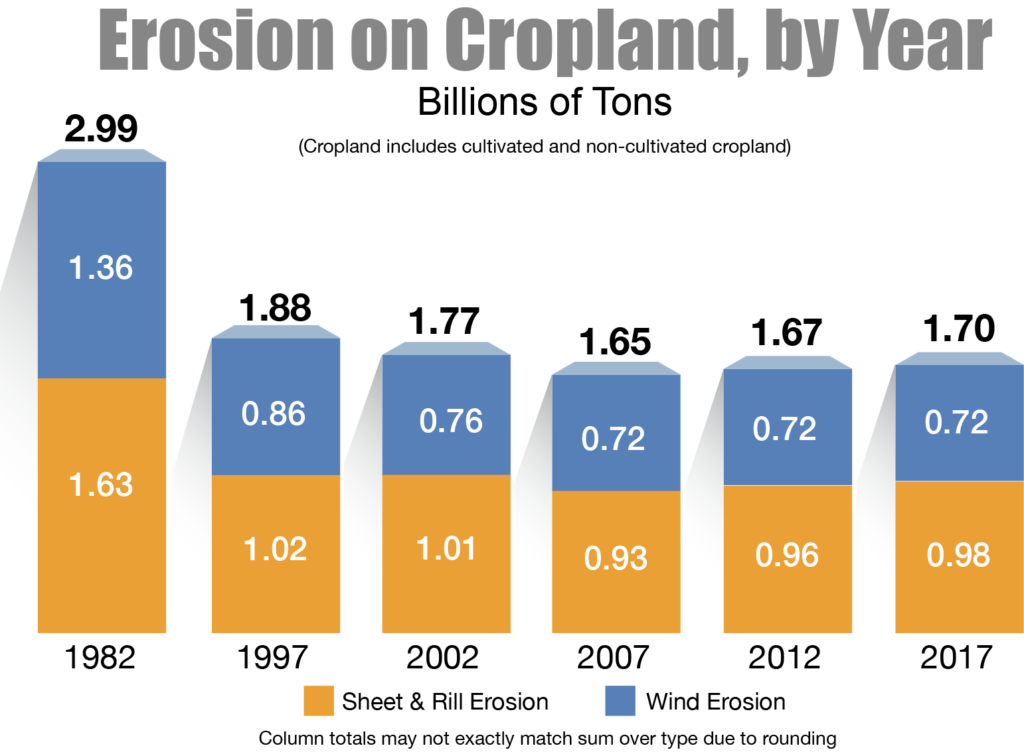
Annual Erosion on America’s Croplands in Billions of Tons
Thus, the potent combination of unrelenting development and land degradation from soil erosion and other factors is reducing America’s productive agricultural land base even as the demands on that same land base from a growing population are increasing.
The 2017 NRI estimated that the amount of cropland in the United States declined from 420.3 million acres in 1982 to 367.5 million acres in 2017, a decrease of 53 million acres (13 percent) in 35 years, an average (mean) of 1.5 million acres per year.
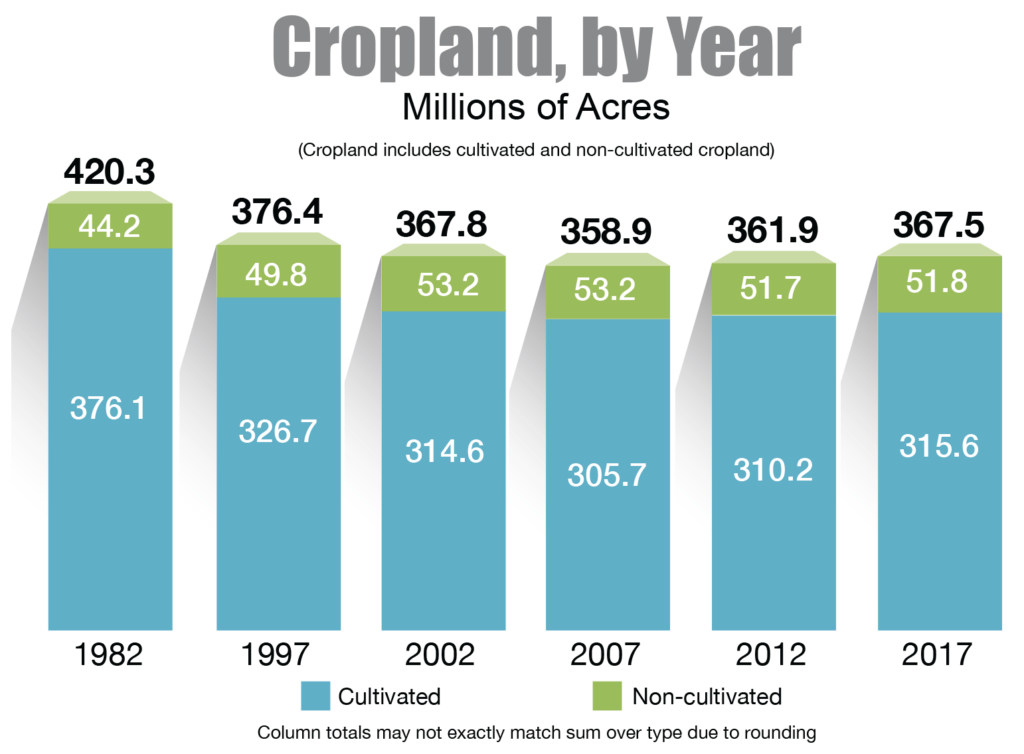
Area of Cropland in the United States, 1982-2017
Some of this cropland (cumulatively, 27 million acres in 2010) was withheld from active farming with federal government support and subsidies and placed into the Conservation Reserve Program (CRP), but these tend to be marginal or fragile sites on which cultivation is not deemed to be sustainable or recommended in any case. With the federal ethanol mandate and strong financial incentives over much of the last couple of decades to grow corn in order to produce ethanol as fuel for vehicles, and with higher food and grain prices overall, farmers had tangible motivation to convert CRP land and pastureland into cropland from 2012 to 2017 as shown in Figure 29. Approximately 89 percent of the modest 3.3% gain in cropland area from 2012 to 2017 (5.6 million acres) came from pastureland and CRP land.
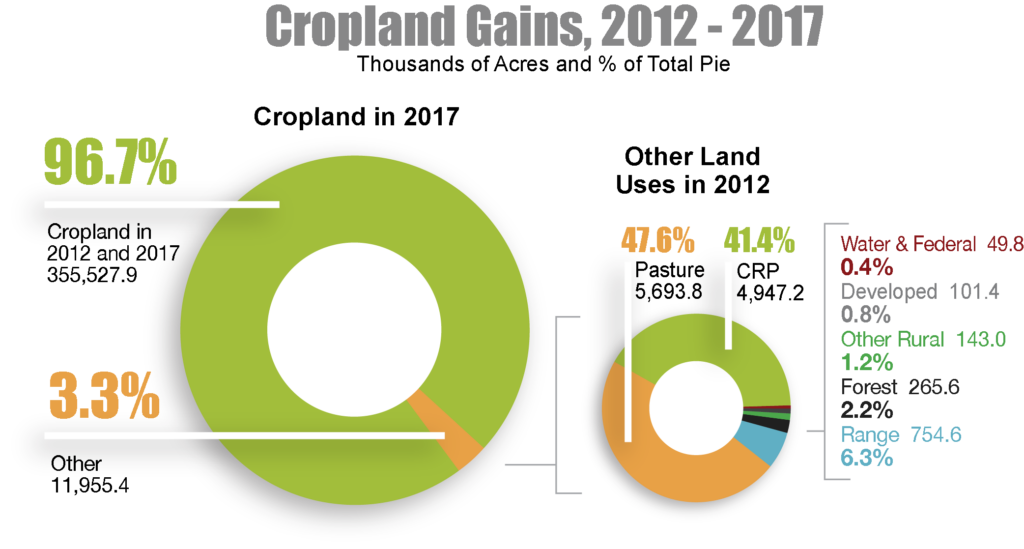
Cropland Gains from other Land Uses from 2012 to 2017
Source: NRCS, 2017. Summary Report: 2017 National Resources Inventory. P. 2-4.
If the same rate of cropland conversion and loss that prevailed from 1982 to 2010 were to continue to the year 2100, the United States would have lost an additional 193 million acres of its remaining 361 million acres of cropland, for a total cumulative loss of 253 million acres. Only 168 million acres would then remain – about 40 percent of the original allotment – and none of this acreage would be in pristine condition after two centuries or so of intensive exploitation. Its soils and nutrients, while perhaps not exhausted, would require even greater inputs of costly fertilizers. Two of the most crucial fertilizers – ammonium nitrate, manufactured from ammonia produced from natural gas (Haber-Bosch process), and phosphorus, produced from phosphate mines – may be far more expensive, perhaps prohibitively so, in 2100 than at present, due to the inexorable depletion of the highest-quality reserves of these non-renewable resources.
The table below shows the amount of cropland per capita in the United States in 1982, 2010, and projected to 2050 and 2100, assuming the same rate of cropland decline from 1982 to 2010 and using Census Bureau projections to 2100. Available cropland would have declined from 1.9 acres per person in 1982 to 0.3 acre per person in 2100, an 84 percent decrease.
1Projected using annual rate of cropland loss from 1982-2010 (2.1 million acres)
2Most recent projections from the United States Census Bureau
3Hollmann et al., 2000.

Projected Long-term Decline in Cropland per Person
However, this dire scenario is unlikely to come to pass, even if the United States continues to reject population stabilization as an acceptable course of action or to enact more aggressive farmland protection measures. This because rising demand and prices for foodstuffs would increase the value of land maintained as cropland vis-à-vis developed land, and because conversion from other types of lands to cropland, including pastureland, rangeland, forested land and other natural areas, would certainly occur.
This actually did occur from 2012 to 2017, during which the area in cropland increased by 5.6 million acres; most of this was pastureland or CRP land pulled back into production because high agricultural commodity prices encouraged farmers to plant it. Again, in an ideal world, erosive or sensitive CRP lands and steeper, less-than-ideal pasturelands should not be cultivated and would best be conserved as wildlife habitat and for pasture and grazing; that is why the voluntary Conservation Reserve Program was established in the first place in the 1980s
Furthermore, the decrease from 1982 to 2017 in the acreage of highest quality soils classified as Prime Farmland, which constitutes only 21 percent (or 313.7 million acres) of the non-Federal rural land base was “only” 15.2 million acres, compared to the 52.8-million-acre decrease in cropland. NRCS states that “most of this loss was due to development.”
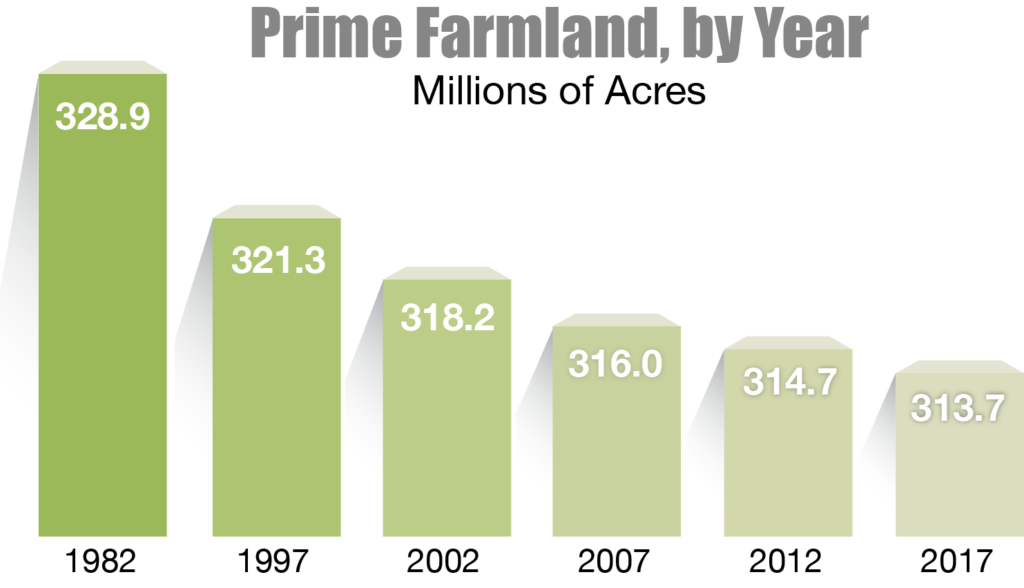
Decrease in Nation’s Inventory of Prime Farmland, 1982-2017
Not all designated Prime Farmland is cultivated as cropland; indeed, only 65 percent of it is cropland; the rest is in other non-developed land uses or cover types.
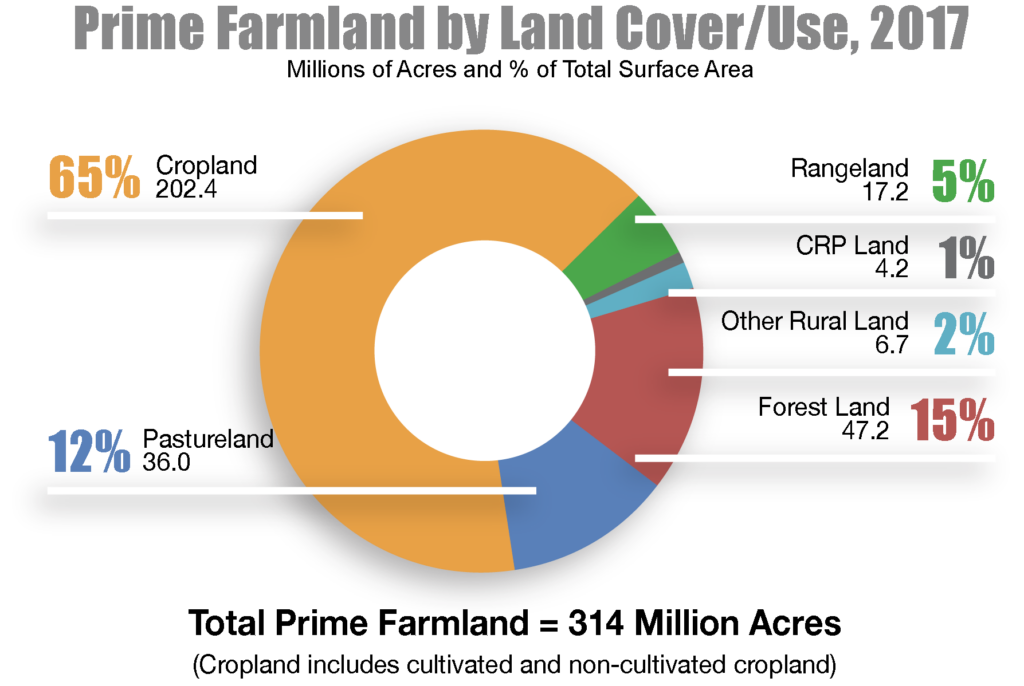
Prime Farmland by Type in 2017
Source: NRCS, 2020. Summary Report: 2017 National Resources Inventory. P. 5-2
Nevertheless, given the projected decline in cropland per capita, that is, the acreage of land on which to cultivate grains and other crops for each resident, biotechnology would have to work miracles in constantly raising yields per acre in order to maintain the diverse, meat-and-dairy-rich diet Americans came to expect in the late 20th and early 21st centuries.
Ominous, divergent trends – an increasing population, a decreasing arable land base, diversions of water supplies needed for irrigated agriculture to urban populations, and a modern, mechanized agriculture that is heavily dependent on limited fossil fuels at all stages – have led some scientists to conclude that someday within this century the United States may cease to be a net food exporter. Food grown in this country would be needed for domestic consumption. By mid-century, the ratio of arable land per capita may have dropped to the point that, “the diet of the average American will, of necessity, include more grains, legumes, tubers, fruits and vegetables, and significantly less animal products.” While this may in fact constitute a healthier diet, it would also represent a significant loss of choice for a country that has always prided itself on its abundant agriculture, plentiful consumer options, and comparative freedom from want.
Preserving farmland and maintaining its fertility is more than a question of producing an adequate supply of food and engendering a healthy diet for Americans, it is a matter of national security. According to Brig. Gen. (Ret.) W. Chris King, Ph.D., P.E., Dean of Academics, U.S. Army Command and General Staff College, Fort Leavenworth, Kansas, without a sustainable environment and resources that meet basic human needs, instability and insecurity will be the order of the day. The World Food Summit held in Rome, Italy in 1996 revived interest in the issue of food security, and thus, in farmland preservation because of its bearing on food security. As the late Oxford ecology professor Norman Meyers noted in a now-classic 1986 article:
“…national security is not just about fighting forces and weaponry. It relates to watersheds, croplands, forests, genetic resources, climate and other factors that rarely figure in the minds of military experts and political leaders…”
One of the lasting effects on the world food system of the global crisis in food prices from 2007 to 2008 has been the accelerating acquisition of farmland in poorer countries by wealthier countries which seek to ensure their own food supplies. As the International Food Policy Research Institute states:
“Increased pressures on natural resources, water scarcity, export restrictions imposed by major producers when food prices were high, and growing distrust in the functioning of regional and global markets have pushed countries short in land and water to find alternative means of producing food.”
By 2009, foreign governments and investors had already purchased more than 50 million acres (78,000 square miles) of farmland – an area the size of Nebraska – in Africa and Latin America
Between 2000 and 2013, more than 1,200 deals had taken place, selling more than 205 million acres (320,313 square miles) of land to foreign investors; 62 percent of these deals took place in hungry Africa, encompassing 138 million acres (215,625 square miles), an area almost twice the size of Nevada, the 7th largest U.S. state.
And it isn’t just Third World farmland that is being bought by well-heeled foreigners. “‘American Soil’ Is Increasingly Foreign Owned” was the headline on a 2019 story on NPR’s All Things Considered. As of 2019, almost 30 million acres of American farmland was owned by foreign investors, a figure which had doubled in the last two decades.
Finally, U.S. agriculture and related food industries contribute nearly $1 trillion to our national economy annually. They comprise more than 13 percent of the GDP and employ 17 percent of the labor force. World demand for U.S. agricultural exports is only expected to increase over the foreseeable future due to a rapidly growing world population, increasing demand for meat and dairy products, and expanding global markets.
Americans are well aware of these food security implications.
In a national poll of 1,500 likely voters in 2020 (see “From Sea to Sprawling Sea,” Appendix G for the entire survey results), the very first question showed that 79 percent overall believed that the destruction of farmland and natural habitat because of urban sprawl in the United States was a “major problem” (44%) or “somewhat of a problem” (35%). In that fourth question of that same poll, when asked if it “is unethical to pave over and build on good cropland,” or if “the need to for more housing is a legitimate reason to eliminate cropland,” 62% responded that it is unethical to do so, more than three times the percentage (18%) who thought that the need for more housing is a legitimate reason.
Questions two and three from the survey are reproduced here:
62% Very important
27% Somewhat important
6% Not very important
1% Not important at all
3% Not sure
32% Very important
45% Somewhat important
16% Not very important
4% Not important at all
3% Not sure